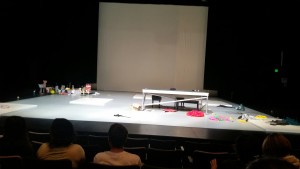By the end of the performance, the stage of Zellerbach Playhouse was strewn with costumes, toys, and vegetables. Five white squares that had served as platforms and pedestals for dancing were empty. The microphones the performers used to address us, to sing, and to provoke “historical impossibilities” lay silent on a table.
Last Thursday, March 17, students in the Big Ideas course taught by Shannon Jackson and Nicholas de Monchaux were invited to attend the dress rehearsal of Trajal Harrell’s “The Ghost of Montpellier meets the Samurai.” Harrell’s visit is part of Cal Performances’ Berkeley RADICAL, and the stillness in the theater when the rehearsal ended––the undergraduate students remained quiet and unmoving, as if glued to their seats––indicated the impact of Harrell’s work. Murmurs of conversations started gradually, as Harrell came to the edge of the stage to speak with the class about his work. When Nicholas de Monchaux asked if anyone had a question about ten hands shot up: students wanted to know how he chose these performers? Why were there tomatoes smashed on the floor? Why was Anna Wintour someone he referenced? Were the sections choreographed or improvised? If there were any mistakes in this rehearsal? Could he feel the audiences’ responses when he was performing? How would a museum “collect” this piece? And what his least and most favorite sections were? In between these inquiries there were reflections on how the rehearsal resonated with students, how it was unlike anything they had seen, and how they loved its “queerness.”
Indeed, if “queering” a topic is to disrupt and intervene in a sense of predictability or heteronormative behavior, Harrell’s work is “queer.” It’s layered, clever, and critical, speaking to and through different discourses of dance, visual arts, and fashion. He describes the white squares as a way to “blow up” or display the bodies of the dancers, like a plinth that supports a vase or a runway that elevates a model. The tomatoes are a reference that goes back to Shakespeare: when audiences hated a show, they threw tomatoes at the stage. In Harrell’s version, one of the performers throws tomatoes on the stage, seemingly frustrated and bewildered. Harrell spoke admiringly of his cast: “they choose me as much as I choose them! They have to want to be seen and I have to love the way they move.”
Asked if there is any warm-up or preparation they do together before a show, Harrell replied that he tells them, “Werq Bitches!” and his performances are work: physical, complicated, drawing on the many talents and knowledges of his dancers to engage with one another and to “calibrate”––Harrell’s word––their actions in accordance with what they feel from their audiences. He added that his references to Anna Wintour and to intersections of “art,” “culture,” and “society,” are meant to provoke us to think about how we value art, as much as to play with his own interest in voguing and Vogue.
The Q & A ended with Nicholas De Monchaux noticing how the performance began and ended with a blurring of both  a starting point and an ending point. As we had entered the theater Thibault Lac, one of Harrell’s performers, was already dancing, a freewheeling solo taking place stage-right in Japanese sandals––Geta––with a medical facemask covering his mouth. The performance ended with the cast still grooving, clapping, bowing, and dancing some more. As de Monchaux observed, Harrell’s work lets us see how indistinct those lines can be between life and art, as well as between what happens inside of theaters, and what’s possible outside of their walls.
a starting point and an ending point. As we had entered the theater Thibault Lac, one of Harrell’s performers, was already dancing, a freewheeling solo taking place stage-right in Japanese sandals––Geta––with a medical facemask covering his mouth. The performance ended with the cast still grooving, clapping, bowing, and dancing some more. As de Monchaux observed, Harrell’s work lets us see how indistinct those lines can be between life and art, as well as between what happens inside of theaters, and what’s possible outside of their walls.
Kate Mattingly graduated from Princeton University with a degree in Architecture and received her master’s of fine arts degree in Dance from NYU where she performed works by William Forsythe and other choreographers. Her articles about dance have been published in the New York Times, Village Voice, Washington Post, Dance magazine, and Dance Research Journal. From 2006 to 2008 she lived in Austria where she worked as a dramaturg for the contemporary performance festival, Sommer Szene. She is currently a doctoral candidate at UC Berkeley.

